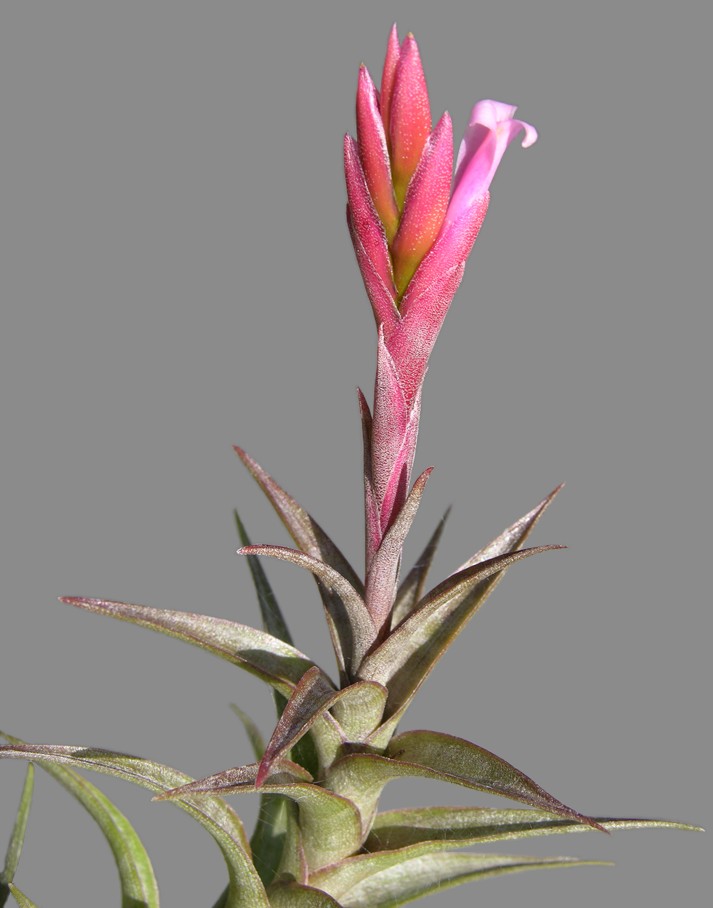
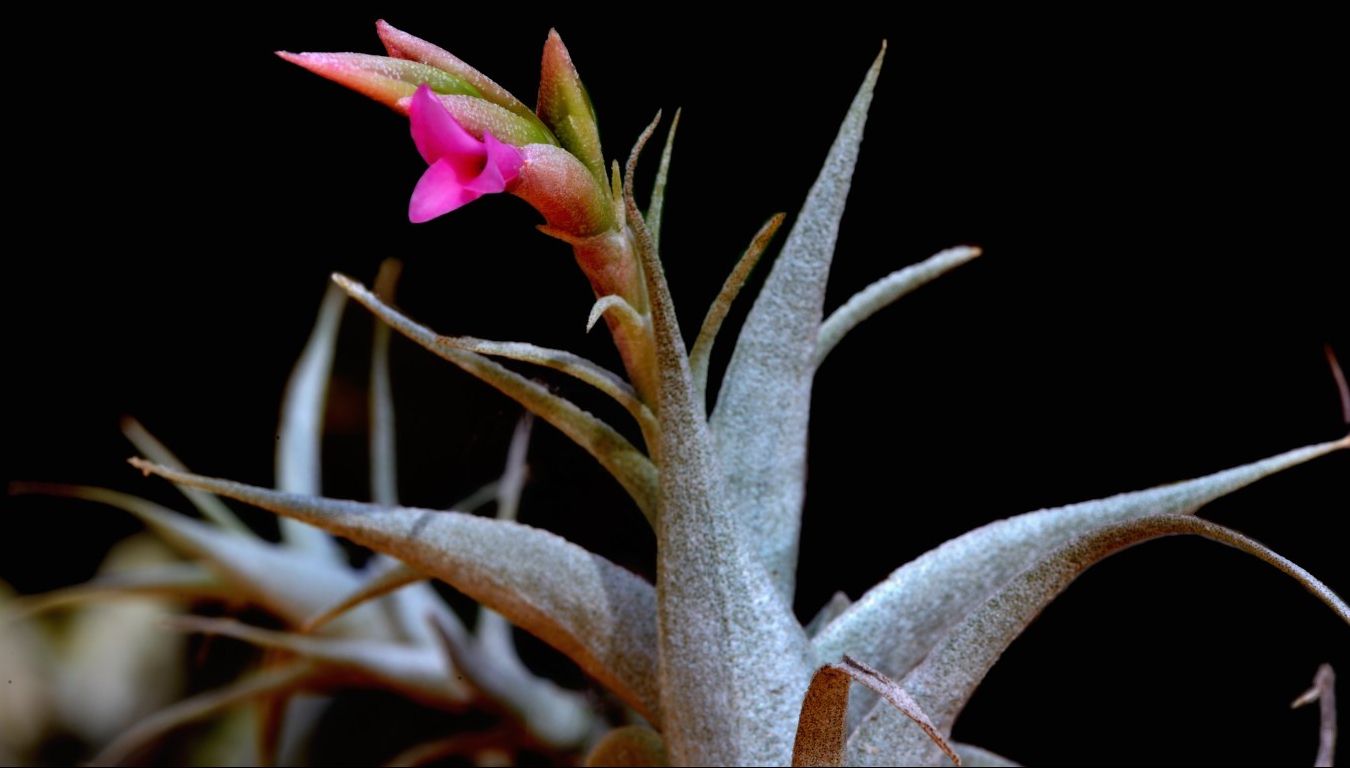
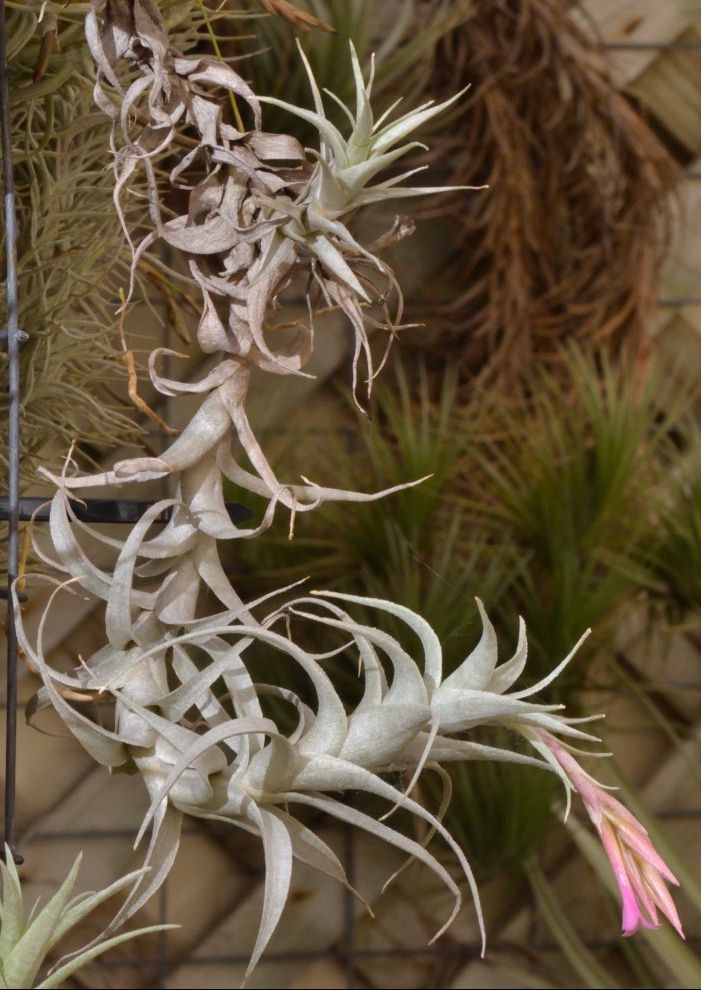


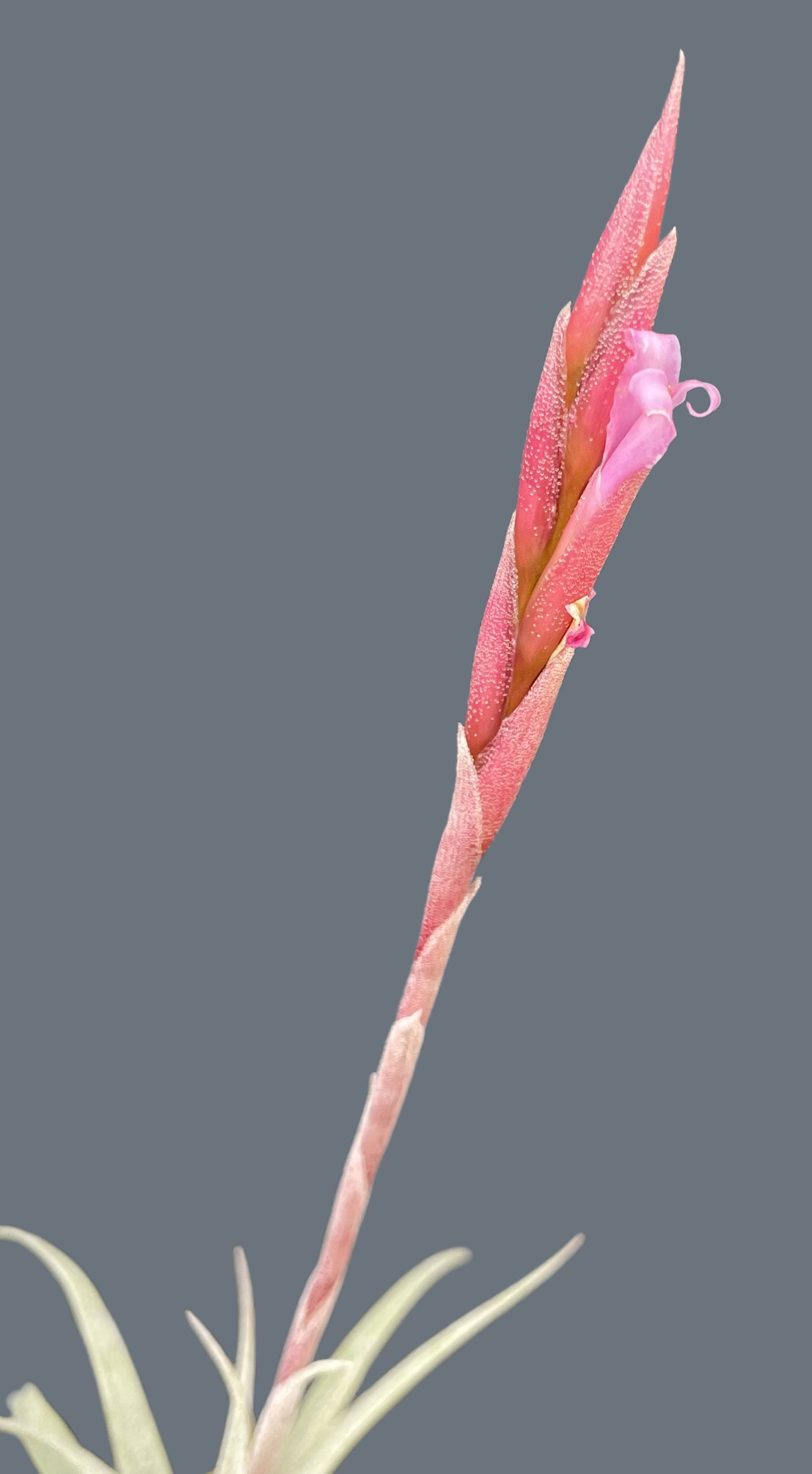
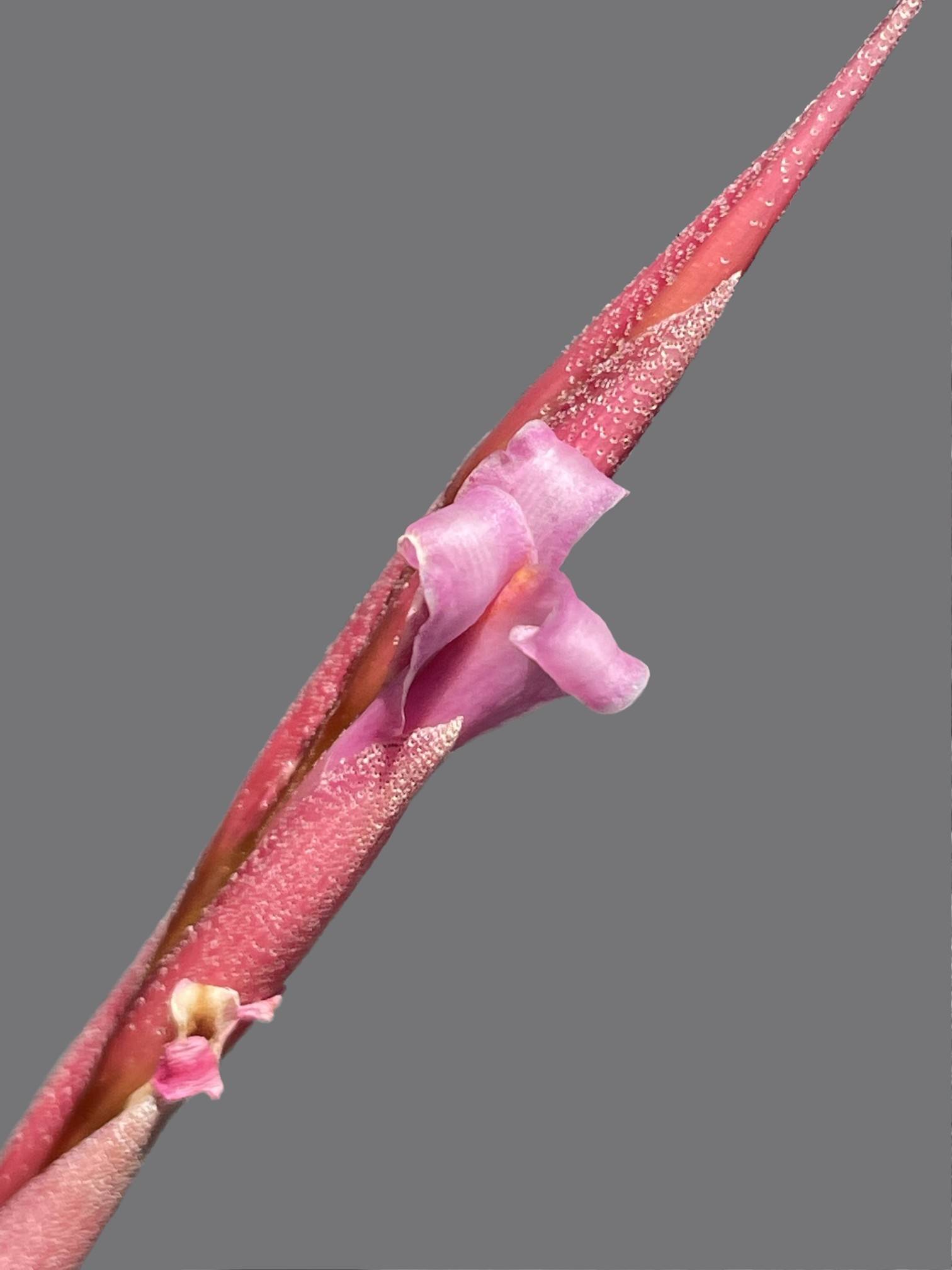
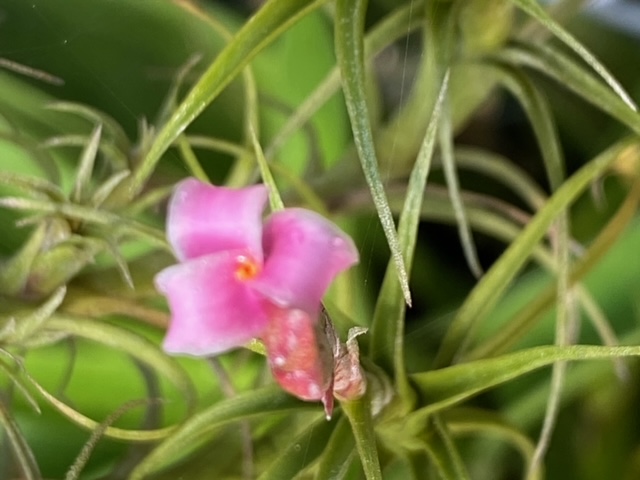
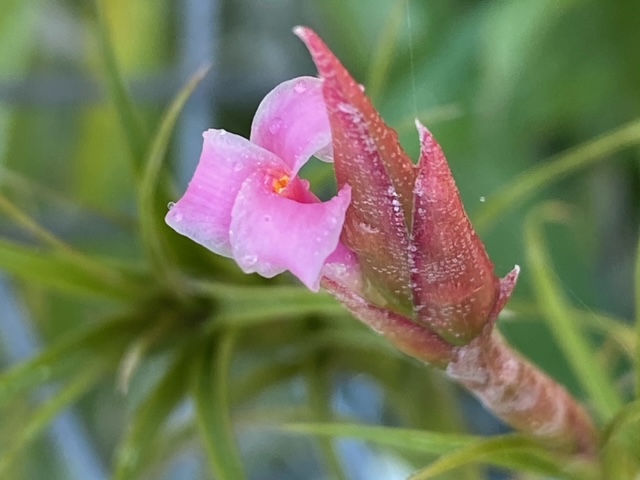

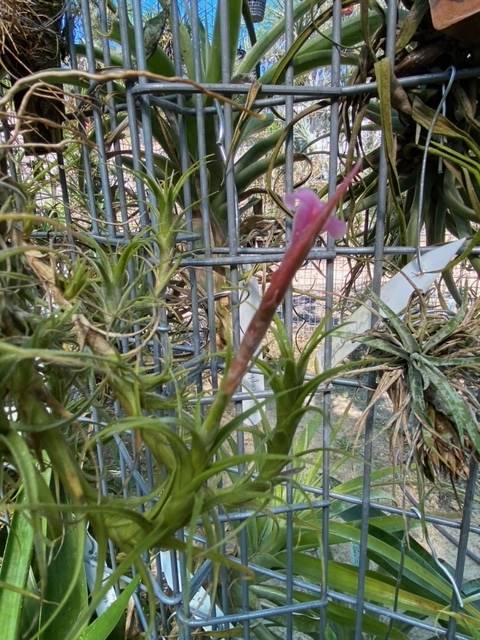

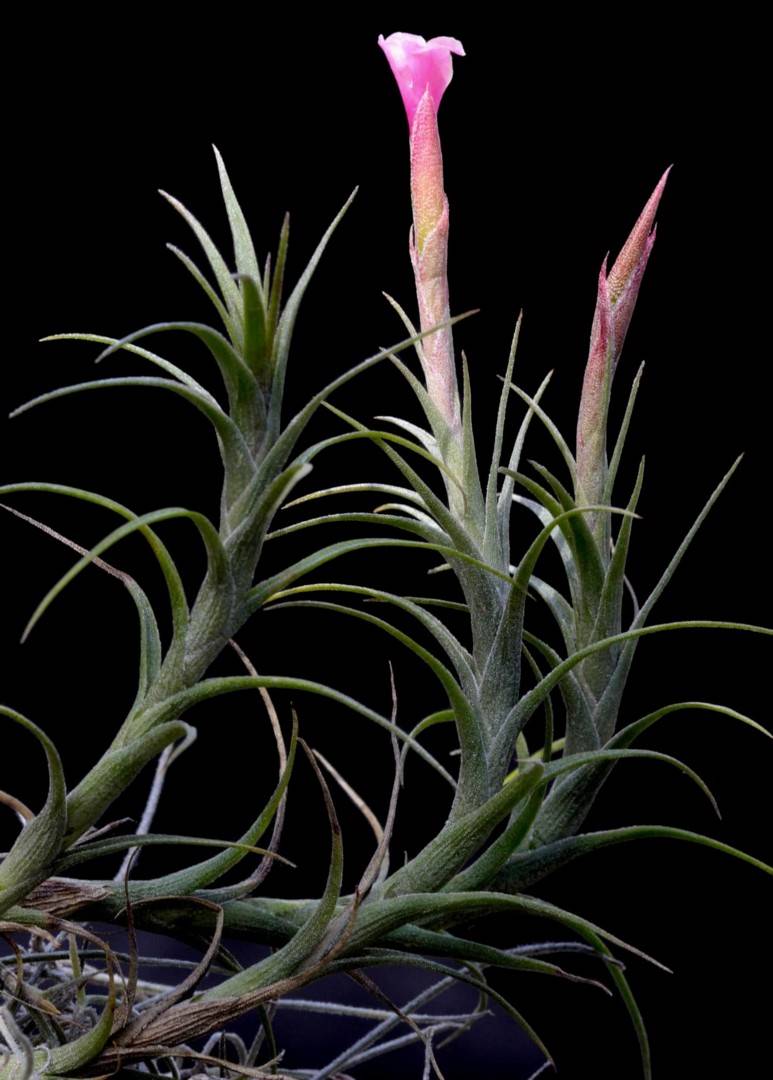
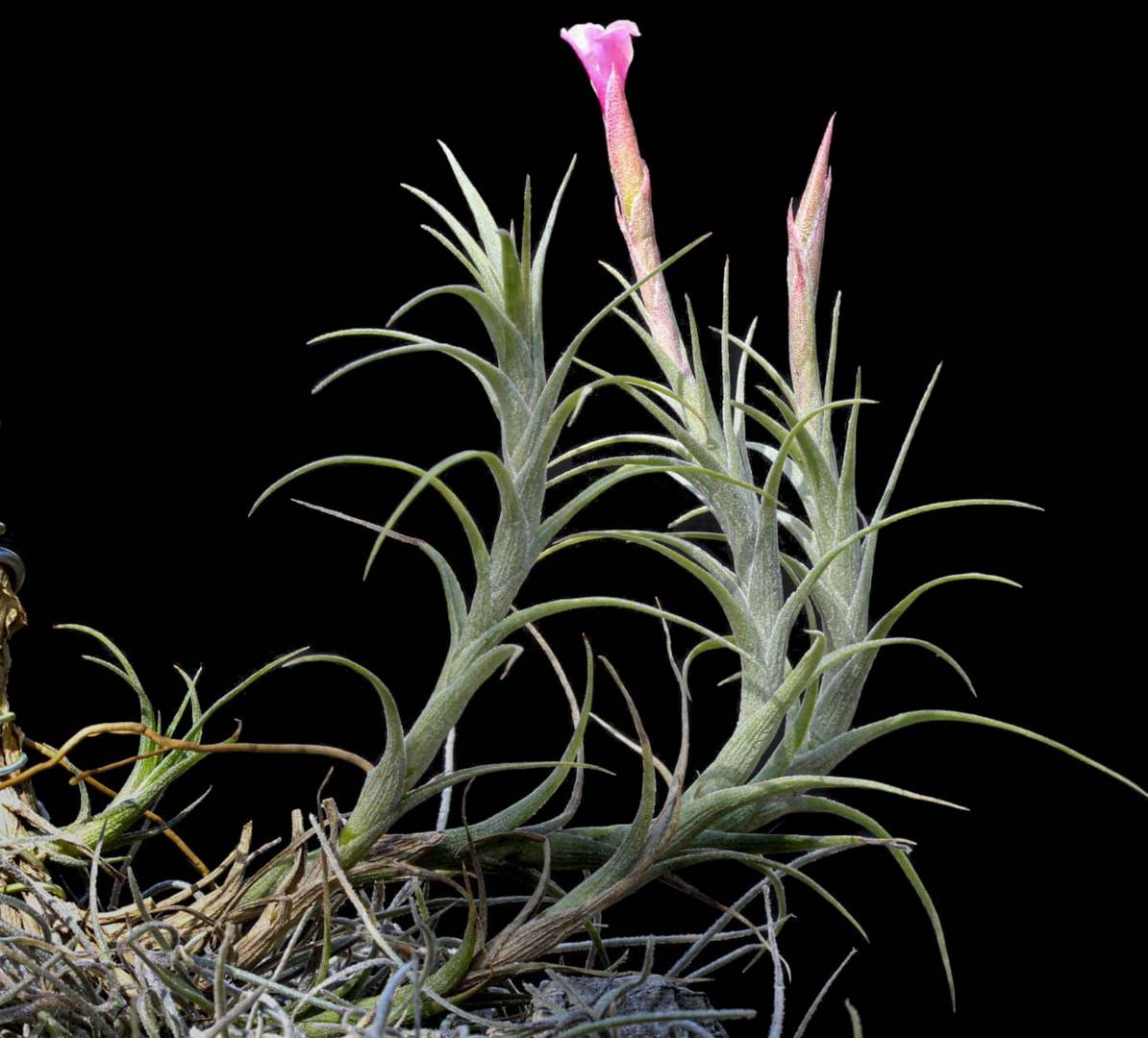
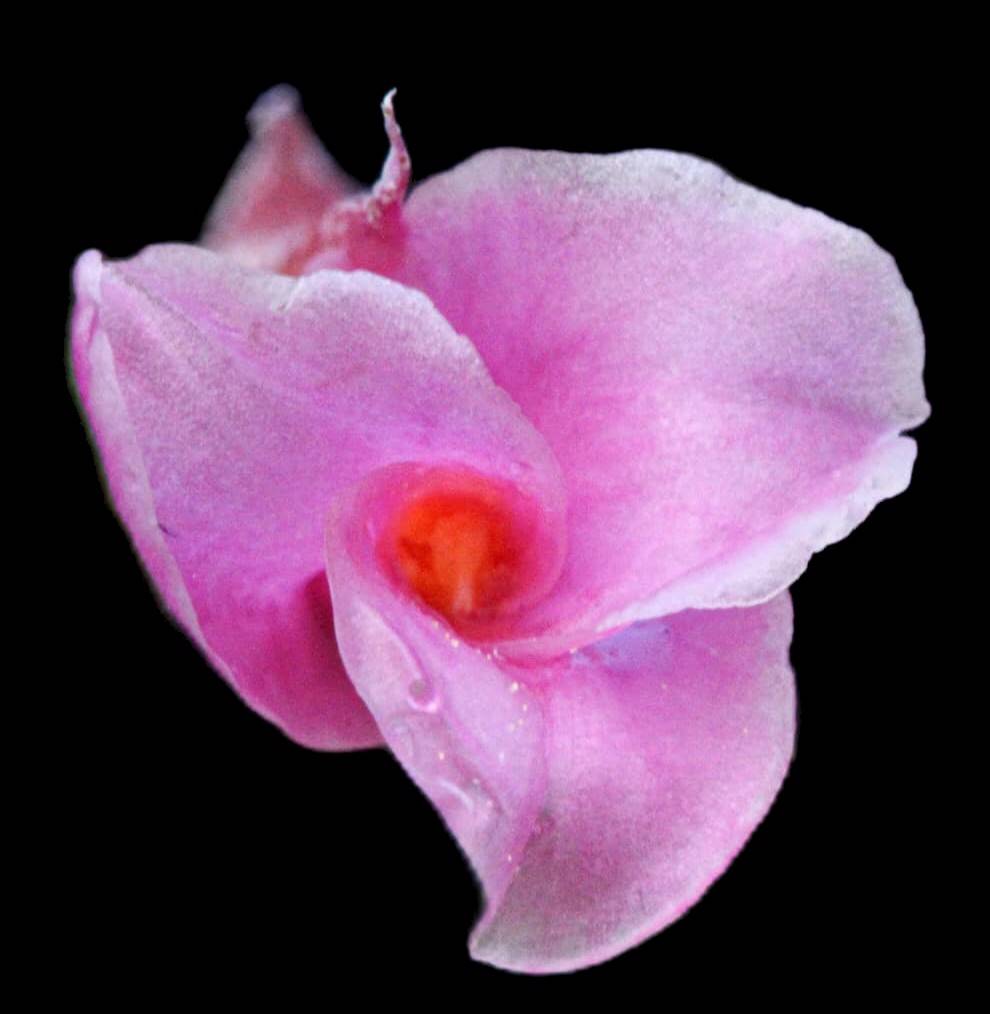
Tillandsia (Allardtia) Macbrideana, spec. nov.,
PERU: HUANUCO: on eastern face of rock cliffs, Llata, alt. 2100 m., 1922, Macbride & Featherstone 2258 (FM, TYPE; G, COTYPE).
In its branched and trailing habit and in its lack of scape this species is strongly suggestive of T. caulescens, but its inflorescence is much shorter and broader closely resembling that of T. complanata and its leaf-blades are broadly triangular instead of nearly linear as in T. caulescens. Its most peculiar feature is the combination of a distichous spike with a style shorter than the stamens, thus combining characters of the sections Allardtia and Anoplophytum. However, it seems most closely allied to species which definitely belong to Allardtia, so I am tentatively placing it there.
Desc from S&D
Plant over 3 dm long; roots present; stem much branched, also sending out slender, stolons with reduced leaves.
Leaves polystichous, densely imbricate, 3-4 cm long, densely appressed-lepidote, cinereous;
Sheaths broadly elliptic, 15-20 mm wide, scarcely distinct from the blades and over half as long;
Blades triangular, attenuate, recurved near apex.
Scape very short or lacking.
Inflorescence terminal, simple and distichous-flowered, lanceolate, acute, to 4 cm long, 15 mm broad, 5-10-flowered;
Rhachis nearly straight, glabrous, sulcate, excavated next the flowers.
Floral bracts erect, imbricate, 3-4 times as long as the internodes but so narrow as to expose most of the rhachis at anthesis, lanceolate, broadly acute or obtuse, 2 cm long, exceeding the sepals, not at all carinate, closely striate, thin, densely appressed-lepidote, becoming glabrous, rose;
Flowers subsessile.
Sepals narrowly lanceolate, carinate, glabrous, striate, connate posteriorly for 5 mm;
Petals 25 mm long, narrowly elliptic, obtuse, rose;
Stamens slightly longer than the style, emerging from the throat of the corolla but shorter than the petals;
Anthers very narrow, 7 mm long; filaments straight;
Ovary 3 mm long, ovoid.
TYPE. Macbride & Featherstone 2258 (holotype F, isotype GH), Llata, Huanuco, Peru, 21 Aug 1922.
DISTRIBUTION. Saxicolous on cliffs, 2100-2750 m alt, northern Peru. PERU. AMAZONAS: Chachapoyas: lower eastern Calla-Calla slopes, near km 422 Leimebamba to Balsas, 7 Jul 1962, Wurdack 1165 (US, USM).
Werner Rauh in Trop Subtrop. Pflanz. 53/ 1985 p29-39 created 5 varieties.
VAR. MACBRIDEANA
Plant long stemmed.
Leaf densely imbricate, 3-4cm long.
Scape missing or very short.
Inflorescence very short, 5-10 flowered.
VAR. MAJOR
Plant long stemmed. Living rosette to 20cm (-25) high, erect.
Leaf broad triangular, acuminate, to 10cm long, striking white lepidote, smooth, the back sometimes keeled.
Scape very short, not visible.
Spike long-oval-acuminate, to 7cm long and 2cm wide, to 15 flowered.
Floral bract densely imbricate, pink coloured.
Holotypus : Rauh 53 778 (Juli 1980), im Herb. Inst. f. System. Botanik der Universitat Heidelberg (HEID). Heimat und Verbreitung: Mauern der Inkaruinen von Huamachuco, 2700 m, Dptm. La Libertad (N-Peru).
VAR. LONGIFOLIA
Plant flowering to 20cm high.
Leaf to 15cm long, narrow triangular attenuate, the tip rolled inwards.
Scape clearly visible.
Holotypus : Rauh 53 755 (Juli 1970), im Herb. Inst. f. System. Botanik der Universitat Heidelberg (HEID). Heimat und Verbreitung: 25 km ostl. Cajamarca, 2500 m, an steilen Felswanden, Dptm. Cajamarca (N- Peru).
VAR. LONGISPICA
Leaf wide spreading.
Scape very short barely visible.
Spike to 10cm long, 1.5cm wide, erect, to 20 flowered.
Flower bracts densely imbricate, dark carmine,
Holotypus : Rauh 35 537 (Juli 1977), im Herb. Inst. f. System. Botanik der Universitat Heidelberg (HEID). Heimat und Verbreitung : Zwischen Otusco und La Libertad, an steilen Felswanden, 3000 m, Dptm. La Libertad (N-Peru).
VAR. ATROVIOLACEA
Plant long caulescent spreading to form a loose cushion.
Leaf densely polystichous with erect leathery brown sheath and spreading to reflexed, narrow triangular, attenuate, twisted at the bottom, dark reddish violet blades.
Scape not visible.
Spike simple, mostly bent sideways, to 10 flowered, 5cm long, 2cm wide.
Flower bracts pink.
Holotypus : Rauh 53 856/a (Juli 1980), im Herb. Inst. f. System. Botanik der Universitat Heidelberg (HEID). Heimat und Verbreitung: Steile Kalkfelswande oberhalb Leimebamba, 2700 m, Dptm. Cajamarca (N- Peru).
Tillandsia macbrideana complex
1. Plant - long stemmed -> 2
1. Plant - short stemmed -> 4
2. Leaf - dark violet, narrowly attenuate, scape not visible, spike simple to 5cm long, to 10 flowered, mostly bent sideways, flower bracts pink -> var. atroviolacea
2. Leaf - grey/white, scape not visible -> 3
3. Leaf - 3 - 4cm long; Spike to 4cm long, 5 - 10 flowered, rhachis exposed -> var. macbrideana
3. Leaf - 10cm long. Spike to 7cm long, 15 flowered -> var. major
4. Scape - Not visible, leaves to 10cm long, erect, stiff, spike to 15cm long, rhachis not visible, floral bracts dark-carmine -> var. longispica
4. Scape - Not visible. leaves to 9cm long, sub-erect to subsecund, spike to 5cm long, floral bracts reddish -> gutteana
4. Scape - visible -> 5
5. Sepals - glabrous, petals to 2.8cm long dark-pink, filaments straight, leaves to 15cm long with curled tips. Inflorescence simple, sub-dense -> var. longifolia
5. Sepals - lepidote, petals to 3.7cm long, pale-mauve filaments plicate, leaves to 19cm long, erect or curved, inflorescence simple or with 1 or 2 short side-spikes, rhachis slightly visible -> pseudomacbrideana
With many varieties:
var. macbrideana
Plant long stemmed. Leaves densely imbricate, only 3-4 cm long,( fig. 13; fig. 14). Scape lacking or very short. Inflorescence very short, 5 - to 10-flowers.
Holotype: Macbride & Featherstone 2258, near Llata, Huanucos, 21. 8. 1922, Field museum, Chicago.
Ours in the Rimac-Tal, above Rio Blanco, 2700 m, Dptm. Lima, central-Peru, collected plant, Rauh and Von Bismarck 32 571, 1974, var. macbrideana corresponds with the Type (fig. 14).
The plants of all above locations in North Peru are admittedly correct in the inflorescence - and floral construction with var. macbrideana, usually, above all regarding its size, form, colour, length of leaves and inflorescence from the type however, so that they should be described as varieties.
An especially large variety is our Collection Nr. 53 778, that in large supply overhangs with its long stems, the walls of the old Inca ruins at Huamachuco (fig. 15; fig. 16). It grows here together with T. walteri Mez var. herrerae (Harms) Rauh and differs from the Type through its size. The living rosettes known always in groups with offsetting become 20, -25, cm large. The plant shall on the basis of its size is described as
var. major Rauh var. nov
Planta longe caulescens. Rosulae usque ad 25 cm altae. Folia late triangulo-acuminata, usque ad 10 cm longa, apice recurvata, albo-lepidota, dorso saepe carinata. Scapus inflorescentiae breve invisibilis.
Inflorescentia spicam usque ad 7 cm longam, 2 cm latam, usque ad 15 floram, acuminatam formans. Bracteae florales dense imbricatae, roseae.
Differ from the Type in following characteristics:
Plant with long stem,( fig. 16, left). Living rosettes up to 20, -25, cm high, erect. Leaves broad-3-angular-acuminate, to 10 cm long, notably white lepidote, flattened, at the back from time to time keeled (fig. 16, right). Scape very short, not visible. Spike long-oval-acuminate, to 7 cm long and 2 cm wide, to 15-flowers. Floral bracts densely imbricate, pink-coloured.
Holotype: Rauh 53 778 (July 1980), in HEID.
Habitat & range: walls of the Inca ruins of Huamachuco, 2700 m, Dptm. La Libertad (N-Peru).
Our Coll. Nr. 53 755, 25 km east of Cajamarca, with long attenuate leaves shall be known as:
var. longifolia Rauh var. nov
Planta florens usque ad 20 cm alta. Folia rosulae usque ad 15 cm longa, anguste triangula, attenuata, apice filiformi involuta. Scapus inflorescentiae distincte visibilis.
Differs from the Type in following characteristics:,
Leaves to 15 cm long, with long attenuate, spirally rolled up tip. Scape clearly developed and visible, (fig. 17).
Holotype: Rauh 53 755 (July 1970), in HEID. Habitat & Range: 25 km east of Cajamarca, 2500 m, on steep rocks, Dptm. Cajamarca, N. Peru.
A remarkable form is our Coll. Nr. 35 537, that was collected growing at 3000 m high on steep chalk cliffs between Otusco and Coina (Dptm. La Libertad), It has a notably long, narrow, upright spike and shall be known as
var. longispica Rauh var. nov
Planta caespitosa. Folia rosulae divaricata. Scapus inflorescentiae brevissimus parum visibilis. Spicae usque ad 10 cm longae, 1,5 cm latae, erectae, usque ad 20 florae. Bracteae florales dense imbricatae atrocarmineae. Flores rosei.
Differs from the Type in following characteristics:
Spike very long, to 15 cm, 1,5 cm wide, stiffly upright, up to 20-flowers; floral bracts densely imbricate, dark-crimson,( fig. 18,); scape not visible.
Holotype: Rauh 35 537 (July 1977), in HEID. Habitat & Range: Between Otusco and La Libertad, on steep tocks, 3000 m, Dptm. La Libertad (N Peru).
A form conspicuous by its leaf colour grows on steep chalk cliffs, (fig. 19), above Leimebamba (2700 m) on the way Cajamarca -Celendin - Balsas. We found the plant on one virtually unaccessible steep area. It forms here large, lax, made from numerous very long stemmed (fig. 20a), to 1.5 m in diameter, cushions (fig. 19), that distinguishes itself through a conspicuous, dark-red-violet coloured leaf. Unfortunately, this conspicuous colour gets lost in cultivation. Our collection Nr. 53 856/a (July 1980) {Freshly collected by W. Krahn, Stuttgart, at the same location under the B.G.H. No. 50 875. Presumably also that of J. Wurdack collected plant (No. 1 165, km 422 Leimebamba – Balsas), can be linked to the var. atroviolacea, ( Herbarium material not seen not)}.
Shall be known as
var. atroviolacea Rauh var. nov
Planta longe caulescens lax pulvinata. Folia divaricata lamina anguste triangula, attenuata, basi involuta, atroviolacea. Scapus inflorescentiae invisibilis. Spica deorsum curvata, usque ad 5 cm longa, 2 cm lata, usque ad 10 flora. Bracteae florales roseae.
Differs from the Type in following characteristics:
Plant with long, to 30 cm, upright or rising, very densely bracted stems; these by reason of richly offsetting forms lax cushions, (fig. 20a). Leaves densely spirally arranged with upright, leathery brown sheath and spreading to bent over, narrow triangular, attenuate, involute at the base, dark-red-violet blades,( fig., 20). Inflorescence usually bent downwards, with short, hidden in the rosette, scape. Spike simple, to 10-flowered, to 5 cm long and 2 cm wide. Floral bracts pink coloured. Flowers, like with all T. macbrideana varieties, shining pink coloured.
Holotype: Rauh 53 856/a (July 1980), in HEID. Habitat & Range: steep chalk cliffs above Leimebamba, 2700 m, Dptm. Cajamarca, N Peru.
From the installation of a Key of the varieties of T. macbrideana it was foreseen in the first instance we are convinced that further varieties will be located in North Peru proving it is a very variable species.